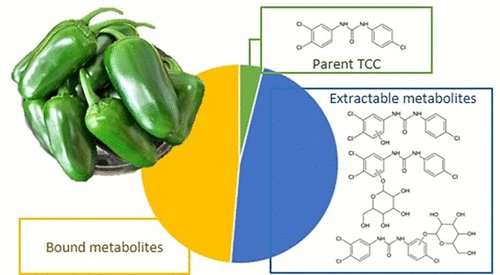Pepper plant sops up personal care product antibiotic

It sometimes can be hard to find toothpastes, soaps and other toiletries without antibiotics. Their popularity has caused an increase in environmental levels of antimicrobial substances, such as triclocarban (TCC), which end up in the water and soil used to grow crops. Scientists report in the ACS' Journal of Agricultural and Food Chemistry that TCC and related molecules can end up in food, with potentially negative health effects.
The U.S. Food and Drug Administration recently banned TCC from soaps because of questions about its safety and efficacy. Yet, TCC remains in many other products. It's also found in high concentrations in treated wastewater that is sometimes used to irrigate crops. The impact of TCC on human health remains unclear, but it may act as an endocrine disruptor. One obstacle to better understanding the risks of environmental TCC exposure is uncertainty about how much of it ends up in plants, and how plants metabolize the substance. So, Dawn Reinhold and colleagues undertook a study with jalapeno peppers to address this knowledge gap.
To track the antibiotic's journey from water to pepper, the researchers labeled TCC with radioactive carbon (C14). They grew the pepper plants hydroponically and, after 12 weeks, sampled the C14 content in the roots, stems, leaves and fruit. While the pepper fruit itself had relatively low levels of TCC, it contained a hefty portion of C14 in molecules that started out as TCC but then were converted to other molecules by the plant. According to the researchers, this finding indicated that the plant was metabolizing the antibiotic, and the health impact of these metabolites would need to be taken into account to fully assess the safety of TCC consumption.
More information: Khang Huynh et al. Transformation, Conjugation, and Sequestration Following the Uptake of Triclocarban by Jalapeno Pepper Plants, Journal of Agricultural and Food Chemistry (2018). DOI: 10.1021/acs.jafc.7b06150
Abstract
Plant uptake and metabolism of emerging organic contaminants, such as personal-care products, pose potential risks to human health. In this study, jalapeno pepper (Capsicum annuum) plants cultured in hydroponic media were exposed to both 14C-labeled and unlabeled triclocarban (TCC) to investigate the accumulation, distribution, and metabolism of TCC following plant uptake. The results revealed that TCC was detected in all plant tissues; after 12 weeks, the TCC concentrations in root, stem, leaf, and fruit tissues were 19.74 ± 2.26, 0.26 ± 0.04, 0.11 ± 0.01, and 0.03 ± 0.01 mg/kg dry weight, respectively. More importantly, a substantial portion of the TCC taken up by plants was metabolized, especially in the stems, leaves, and fruits. Hydroxylated TCC (e.g., 2′-OH TCC and 6-OH TCC) and glycosylated OH-TCC were the main phase I and phase II metabolites in plant tissues, respectively. Bound (or nonextractable) residues of TCC accounted for approximately 44.6, 85.6, 69.0, and 47.5% of all TCC species that accumulated in roots, stems, leaves, and fruits, respectively. The concentrations of TCC metabolites were more than 20 times greater than the concentrations of TCC in the above-ground tissues of the jalapeno pepper plants after 12 weeks; crucially, approximately 95.6% of the TCC was present as metabolites in the fruits. Consequently, human exposure to TCC through the consumption of pepper fruits is expected to be substantially higher when phytometabolism is considered.
Journal information: Journal of Agricultural and Food Chemistry
Provided by American Chemical Society
















